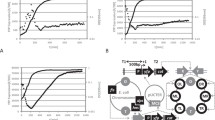Summary
Yudkin (1986) has shown that the spoIIAC gene of Bacillus subtilis cannot be cloned in Escherichia coli in such an orientation that it is expressed. This toxicity of the gene product has been attributed to its close homology with the sigma subunit of the E. coli RNA polymerase. The effect of six individual mutations in spoIIAC has now been studied. All six mutant genes could be cloned in E. coli in an orientation that does not allow expression. When in the orientation that permits expression, one mutant gene could not be cloned, and a second substantially hampered growth; both mutations lie in the region that is believed to encode the DNA-binding domain of the protein. By contrast, two missense mutations in the region of the gene thought to encode the domain that binds to the core RNA polymerase rendered the protein harmless in E. coli, as did two nonsense mutations.
Similar content being viewed by others
References
Errington J, Mandelstam J (1983) Variety of sporulation phenotypes resulting from mutations in a single regulatory locus, spoIIA, in Bacillus subtilis. J Gen Microbiol 129:2091–2101
Errington J, Fort P, Mandelstam J (1985) Duplicated sporulation genes in bacteria: implications for simple developmental systems. FEBS Lett 188:184–188
Fort P, Piggot PJ (1984) Nucleotide sequence of sporulation locus spoIIA in Bacillus subtilis. J Gen Microbiol 130:2147–2153
Gribskov M, Burgess RR (1986) Sigma factors from E. coli, B. subtilis, phage SP01, and phage T4 are homologous proteins. Nucleic Acids Res 14:6745–6763
Piggot PJ, Curtis, CAM, de Lencastre H (1984) Use of integrational plasmid vectors to demonstrate the polycistronic nature of a transcriptional unit (spoIIA) required for sporulation of Bacillus subtilis. J Gen Microbiol 130:2123–2136
Stragier P (1986) Comment on ‘Duplicated sporulation genes in bacteria’ by J. Errington, P. Fort and J. Mandelstam (FEBS Letters 188 (1985) 184–188). FEBS Lett 195:9–11
Stragier P, Parsot C, Bouvier J (1985) Two functional domains conserved in major and alternate sigma factors. FEBS Lett 187:11–15
Yanisch-Perron C, Vieira J, Messing J (1985) Improved M13 phage cloning vectors and host strains: nucleotide sequences of the M13mp18 and pUC19 vectors. Gene 33:103–119
Yudkin MD, (1986) The sigma-like product of sporulation gene spoIIAC of Bacillus subtilis is toxic to Escherichia coli Mol Gen Genet 202:55–57
Yudkin MD (1987) Structure and function in a Bacillus subtilis sigma factor: molecular nature of mutations in spoIIAC. J Gen Microbiol 133:475–481
Yudkin MD, Turley L (1980) Suppression of asporogeny in Bacillus subtilis. Allele-specific suppression of a mutation in the spoIIA locus. J Gen Microbiol 121:69–78
Author information
Authors and Affiliations
Additional information
Communicated by D. Goldfarb
Rights and permissions
About this article
Cite this article
Yudkin, M.D., Harrison, D. Effect of precisely identified mutations in the spoIIAC gene of Bacillus subtilis on the toxicity of the sigma-like gene product to Escherichia coli . Molec Gen Genet 209, 333–334 (1987). https://doi.org/10.1007/BF00329662
Received:
Issue Date:
DOI: https://doi.org/10.1007/BF00329662




